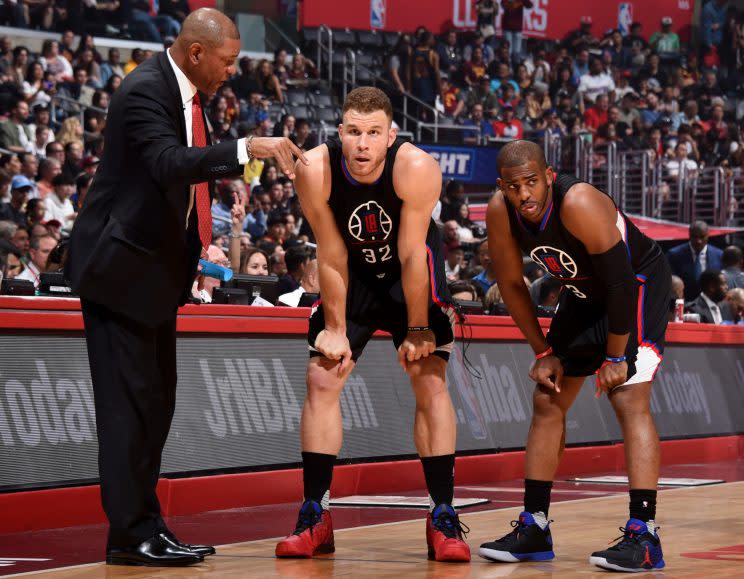In re-signing Blake Griffin, the Clippers took the worst type of NBA risk
Less than 24 hours before the start of NBA free agency, it appeared that Blake Griffin was seriously considering a future outside of Los Angeles. With several disappointing seasons in his rear-view mirror and his point guard of six years gone to Houston, it seemed like Griffin was truly and sincerely on the market. One of the top five available players had scheduled meetings with the Phoenix Suns and Denver Nuggets, while other potential suitors waited in the wings.
Only several hours before the opening bell, however, Griffin “walked into a Blake Griffin museum,” and came out of it with an agreement to stay in L.A.
He also came away from his “walk down memory lane” with a five-year, $173 million max contract, an unthinkable sum for such an injury-prone player, and a deal that represents the worst type of risk that an NBA franchise can take.
Risk has been one of many byproducts of the Golden State Warriors’ dominance, a necessary response that the Warriors’ near-invincibility has elicited from other NBA front offices. With the bar for title contention set so high, general managers understand that they must elevate their ceiling, even if efforts to do so also lower the team’s floor. Golden State has forced their hand.

“If Golden State makes the odds longer, we might up our risk profile and get even more aggressive,” Rockets general manager Daryl Morey told ESPN in a story published the morning after the Warriors’ win in Game 5 of the 2017 NBA Finals.
Morey did just that on Wednesday, trading for Chris Paul. The Oklahoma City Thunder followed suit hours before the start of free agency by dealing for Paul George, despite the possibility that George will be a one-year rental. Paul, also in the final year of his contract, could present a questionable fit alongside MVP runner-up James Harden. Both moves carried potential pitfalls. But the upside matched, or even dwarfed, the downside. Both were prototypical examples of NBA risk-taking.
[Follow Ball Don’t Lie on social media: Twitter | Instagram | Facebook | Tumblr]
Not all NBA risks, however, are created equal. The one undertaken by Doc Rivers, Jerry West and the Clippers illustrates the point.
The prototypical risk model is rather simple. The Rockets and Thunder acknowledged that “mediocre” and “pretty good” aren’t good enough. They climbed higher, with the understanding that a fall would be harder, but also with the knowledge that the worst possible outcome — bottoming out and rebuilding — is better than being mired in the NBA’s struggling middle class. The “high-risk, high-reward” label is apt.
The Clippers’ move carries a similarly high degree of risk. Griffin has not played 70 games in a season since 2013-14. What’s more, the Clips’ record with him sidelined is not significantly worse than it is with the former No. 1 overall pick on the court. And it is significantly better than L.A.’s record with Griffin in the lineup and Paul on the bench. Those facts don’t support handing Griffin the second-richest contract in NBA history.
But that’s not the full reason the move is misguided. The reason is the risk model. This isn’t high-risk, high-reward. It’s high-risk, “meh”-reward. With Paul gone and Griffin on board, the Clippers’ ceiling is as the fourth or fifth best team in the West. It is lower than it has been over the past six years, when the surrounding pack was weaker and the Clippers still failed to even reach the conference finals.
Crucially, the floor is also lower. Whereas the Thunder, for example, could potentially lose both George and Westbrook and subsequently rebuild using cap space and high draft picks, the Clippers have locked themselves into a contract that, if things go awry, could become virtually untradable. It could hamstring the Clippers into next decade and make bottoming out significantly less effective.
Regardless of Griffin’s health, the contract will inhibit the Clippers’ efforts to retool. Even if it proves to be a good value, Rivers and West will find it difficult to build around Griffin in a stacked Western Conference. If injuries hit or Griffin’s performance prematurely declines, Rivers and West can’t pull the plug. They’re committed to this.
But, when you think about it, what are they really committed to? First-round playoff exits? Being merely above average?
The fifth year and lofty dollar figure were likely necessary to get Griffin. And Griffin was necessary to stay competitive, which was imperative for a franchise in the second-most crowded sports market in America, and for a team that for so long has operated in the shadow of the Lakers. Should the purple and gold start rising led by No. 2 overall draft pick Lonzo Ball, the red and blue had to avoid slipping in the other direction. They had to stay relevant. From that standpoint, deciding to give Griffin a fifth year is understandable.
From a basketball perspective, though, the risk outweighs the relatively scant reward. This attempt to prolong an unsalvageable era of Clipper basketball was ill-advised the moment the fifth year was hesitantly placed on the table. And there’s a chance it will haunt the franchise for years to come.
More NBA free agency from Yahoo Sports:
• Dan Wetzel: Confusion and disbelief over the Paul George trade
• Steph Curry’s salary now the highest in U.S. sports
• Grading every Day 1 move, including the Griffin signing
• Why the Pelicans gave Jrue Holiday such a lucrative deal
• Free agency tracker: Follow every move live


